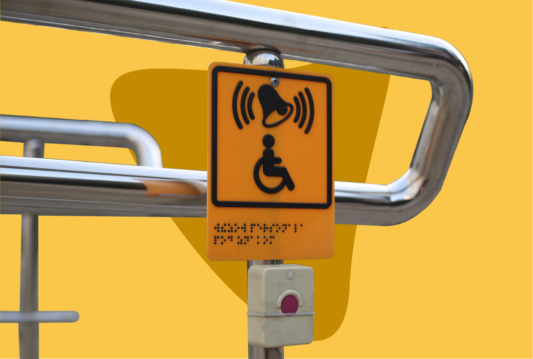The Accessibility for Ontarians with Disabilities Act, 2005 (AODA) establishes and enforces accessibility standards so that goods, services, facilities, and more are accessible to Ontarians with disabilities. Its goal is to increase accessibility throughout Ontario by 2025. People with disabilities often face barriers in their everyday lives that prevent them from fully participating at work or in other aspects of society. By adhering to the AODA standards, organizations remove or reduce barriers so that everyone has equal access to products and services, in a manner that respects the dignity, individuality, independence, and value of people with disabilities. To achieve AODA compliance, there is a requirement to assess, review, and address barriers; provide accessible processes and formats for people with disabilities; train workers on accessibility; and more.
Organizations in Ontario that have one or more employees (including nonprofits, private-sector businesses, and all levels of government) must comply with the AODA. The AODA was enacted to ensure businesses improve processes and policies where these improvements may otherwise have been deemed unnecessary.
6 Steps to Achieve AODA Compliance
While Ontario organizations are legally obligated to follow the AODA’s Integrated Accessibility Standards Regulation, all organizations can look to Canadian human rights and accessibility legislation to inspire positive changes. Though not a complete guide, our steps below will set you on the right track to achieve AODA compliance.
Step 1. Understand Your Obligations
An organization’s AODA requirements and reporting deadlines depend on its size and the type. For example, businesses and nonprofits with fewer than 50 employees do not have to create and maintain a multi-year accessibility plan, but those with 50 or more employees do.
Under the AODA and human rights legislation, organizations with employees must provide reasonable accommodations to people with disabilities and remain accessible to employees throughout the employment lifecycle. While the AODA complements Ontario’s Human Rights Code, it does not supersede the requirements for accessibility and accommodation described in the code.
Step 2. Create Accessibility Policies
The AODA requires Ontario organizations to create and maintain policies that communicate how the organization complies with AODA standards. Policies should address the Integrated Accessibility Standards Regulation (IASR), which falls under the AODA and covers expectations for:
- Customer service;
- Employment;
- Information and communications;
- Transportation; and
- Design of public spaces.
Organizations have the flexibility to create accessibility policies to fit their existing organizational and business practices. An accessibility program may be one policy or several. Alternatively, accessibility considerations may be incorporated into existing policies.
The requirement for organizations is to develop policies on the requirements, or standards, that apply to their business. For example, a grocery store or retail clothing store is not required to develop policies required under the transportation standards as they are not a public transportation service provider.
Organizations who do not already have accessibility policies can download a variety of customizable templates in our leading HR content library.
Step 3: Train Your Workforce
The AODA and IASR require that organizations provide training to their employees and volunteers who work in Ontario. Training should cover the following standards as applicable to the role and duties:
- Customer service standards;
- Information and communications standards;
- Employment standards; and
- Ontario’s Human Rights Code.
To meet this requirement, check out our ready-to-assign training courses on the customer service standards and human rights.
Step 4: Create a Multi-year Accessibility Plan
Designated Ontario public-sector organizations and organizations with 50 or more employees require a multi-year accessibilty plan. At a high level, a multi-year accessibility plan lays out how the organization intends to meet their accessibility requirements based on the IASR, including how it will address any current accessibility barriers and work to prevent and remove barriers. It is important to note that an organization’s accessibility plan is to be considered a living document, with a requirement to review and update the plan every five years.
The plan must be posted on the business’s website and be provided in an accessible format upon request. Citation Canada, formerly HRdownloads, offers a multi-year accessibility plan for AODA requirements in our catalogue of over 2,000 HR documents.
Step 5: Consider Accessibility in Every Business Decision
Like all forms of workplace governance, creating accessible spaces and systems requires constant intentional effort. Consider accessibility in every business decision, such as when buying new equipment or posting a job ad. When in doubt, consult people with disabilities who can advise you on the appropriate ways to remove barriers that affect them.
Step 6: Complete Required Reporting
The AODA requires that a business or nonprofit organization with 20 or more employees, or a designated public-sector organisation, must file an accessibility compliance report every three years. This compliance report confirms that your organization has met the current accessibility requirements under the AODA. Failure to complete and submit this report could result in enforcement measures, which can include financial penalties.
Save Time with an AODA Compliance Checklist
Assess whether your organization is meeting the AODA customer service standards with our FREE AODA Compliance Checklist.
Navigating legislation can be tricky, and deadlines can put additional stress on HR professionals. But worry no more. We are here to help! Get our expert support every step of the way, book a free demo of our services at a time that’s convenient for you!

